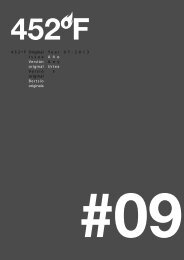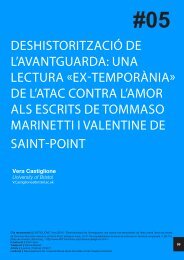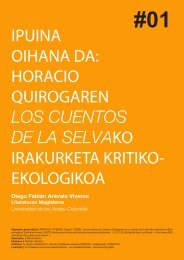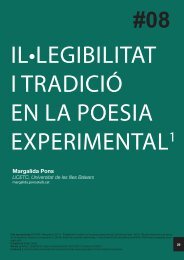03 - 452ºF
03 - 452ºF
03 - 452ºF
Create successful ePaper yourself
Turn your PDF publications into a flip-book with our unique Google optimized e-Paper software.
surpasses this understanding, bringing together disparate fields like<br />
«biology and history, anthropology and philosophy, linguistics and<br />
literature» (Lionnet, 1989: 8). For Lionnet, métissage is also a reading<br />
practice that allows us to underscore the interreferential nature of a<br />
set of texts, which is crucial for the comprehensive understanding<br />
of postcolonial cultures. She cites Teresa de Lauretis, who states<br />
that identity is a strategy so it follows that métissage must be «the<br />
fertile ground of our heterogeneous and heteronomous identities as<br />
postcolonial subjects» (Lauretis, 1986: 9). While there is a reactionary<br />
potential in a separatist search for a unitary and naturalized identity,<br />
a feminist politics of solidarity can protect us from this danger. To<br />
explain, Lionnet says that «solidarity» calls for a particular form of<br />
resistance with intrinsic political ambiguities:<br />
These ambiguities allow gendered subjects to negotiate a space within<br />
the world’s dominant cultures in which the «secretive and multiple<br />
manifestations of Diversity», in Edouard Glissant’s words, will not be<br />
anticipated, accommodated, and eventually neutralized (Lionnet, 1989:<br />
462-463).<br />
A politics of solidarity thus implies the acceptance of métissage as<br />
the only racial ground on which liberation struggles can be fought<br />
(Lionnet, 1989: 8-9). Lionnet argues that when there is a constant<br />
and balanced form of interaction, reciprocal relations tend to prevent<br />
the ossification of culture and encourage systematic change and<br />
exchange. When language responds to such mutations she believes<br />
it reinforces a kind of creative instability in which no ‘pure’ or unitary<br />
origin can be posited.<br />
4. Romeo and Juliet: The intertext<br />
After a long absence, René writes a love letter to Lallia, expressing<br />
his hopes to return to Algeria from France. Lallia has nearly forgotten<br />
about the Cowboy who disappeared before she had so many troubles<br />
at school. Leaning against a low wall after school one day, Lallia<br />
looks up and sees René go by on his bicycle:<br />
Il me fait un grand signe de la main et continue son chemin. Il n’est<br />
même pas venu me voir, je me demande pourquoi il m’a écrit une lettre<br />
alors. Il passe en faisant un signe, comme s’il n’était jamais parti, comme<br />
s’il m’avait vue la veille. C’est un menteur, lui aussi, il me déteste et moi<br />
aussi<br />
[He waves to me and continues on his way. He hasn’t come to see me, I<br />
wonder why he bothered to write me a letter. He passes by with a wave,<br />
like he never left, like he had seen me the day before. He’s a liar too, he<br />
hates me and I hate him] (Lachmet, 1983: 116).<br />
Suddenly, René swerves his bike around and returns to where<br />
Lallia is standing: «René saute et laisse son vélo tomber. Les roues<br />
«Je suis un cowboy du Far West»: A study of textual métissage in Djanet Lachmet’s autobiographical novel Le Cow-boy (1983) - Caroline Kelley<br />
<strong>452ºF</strong>. #<strong>03</strong> (2010) 85-101.<br />
96










